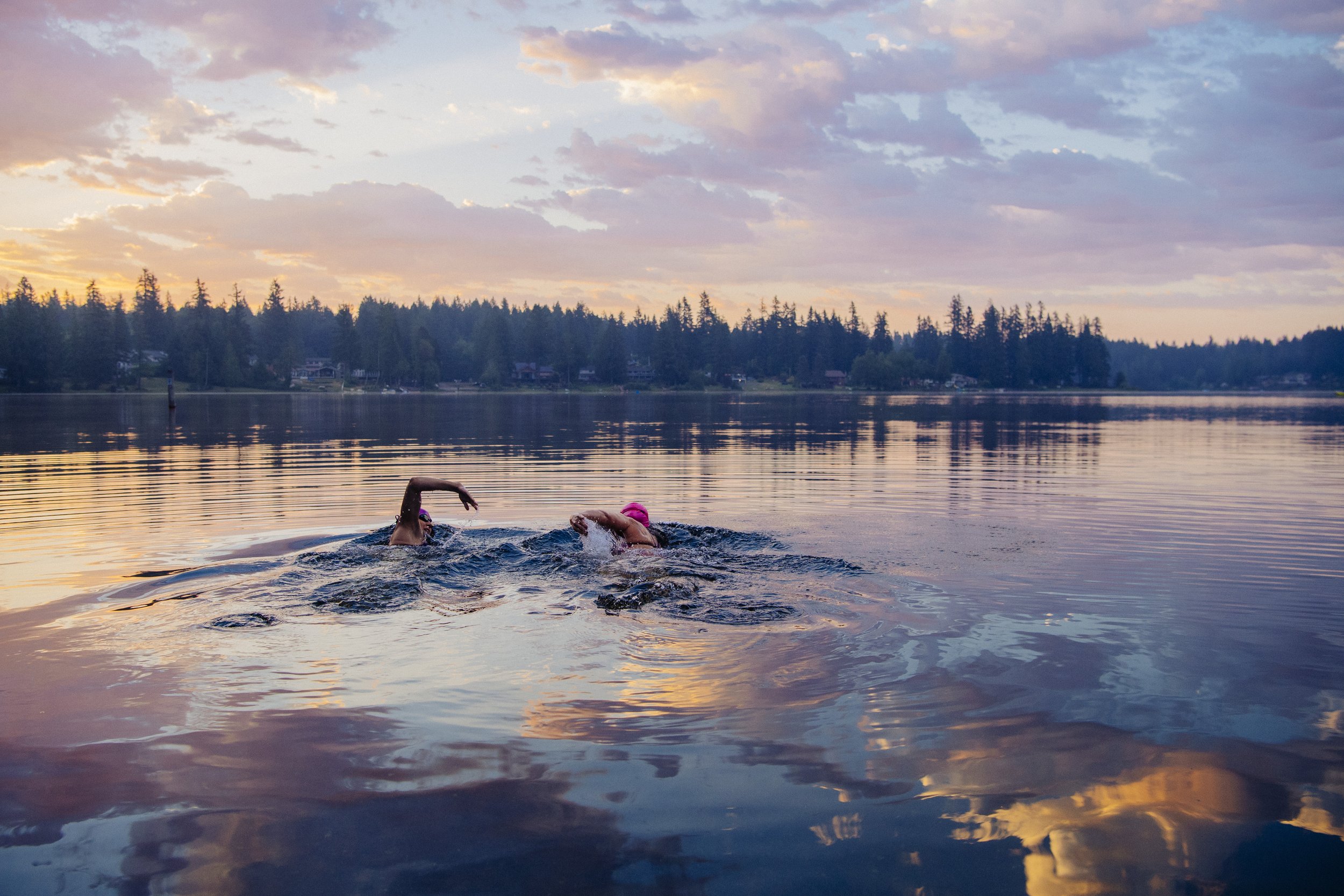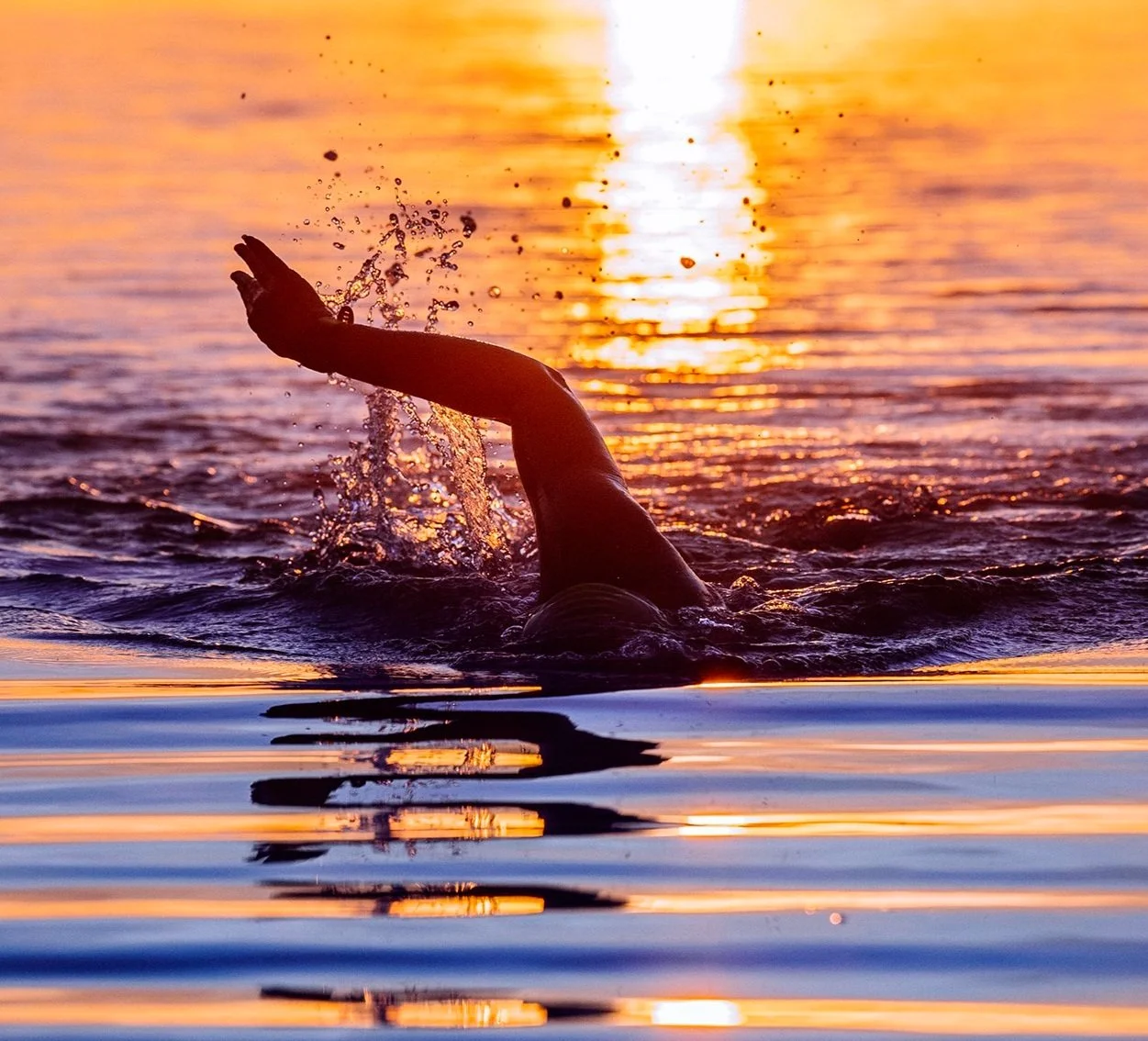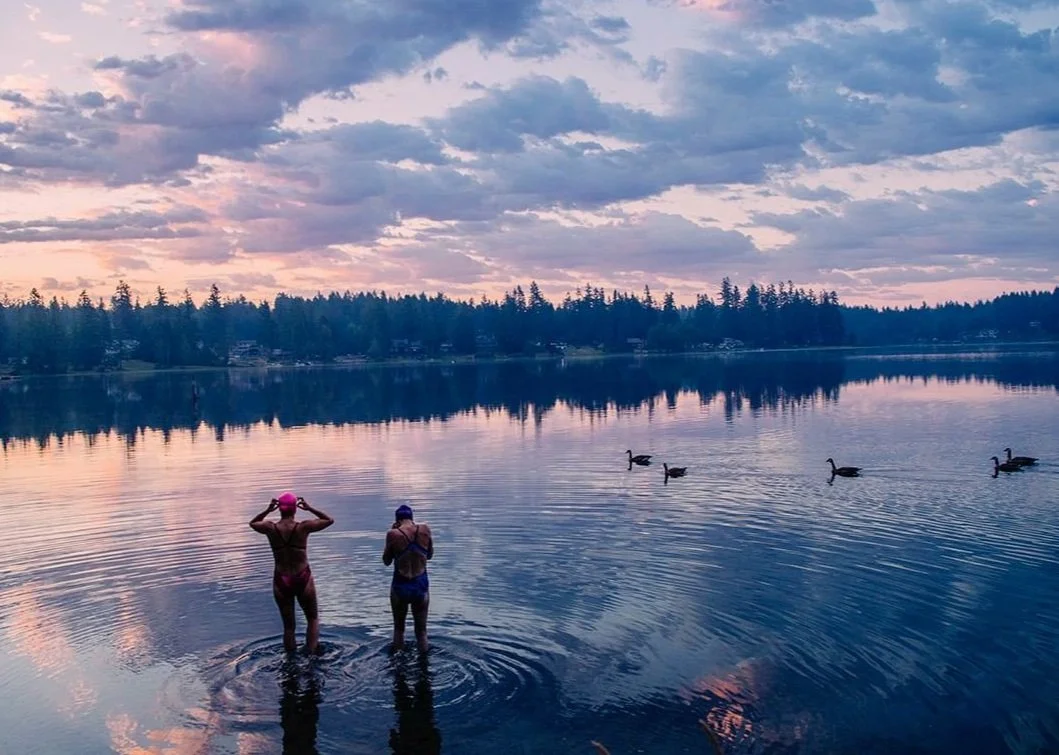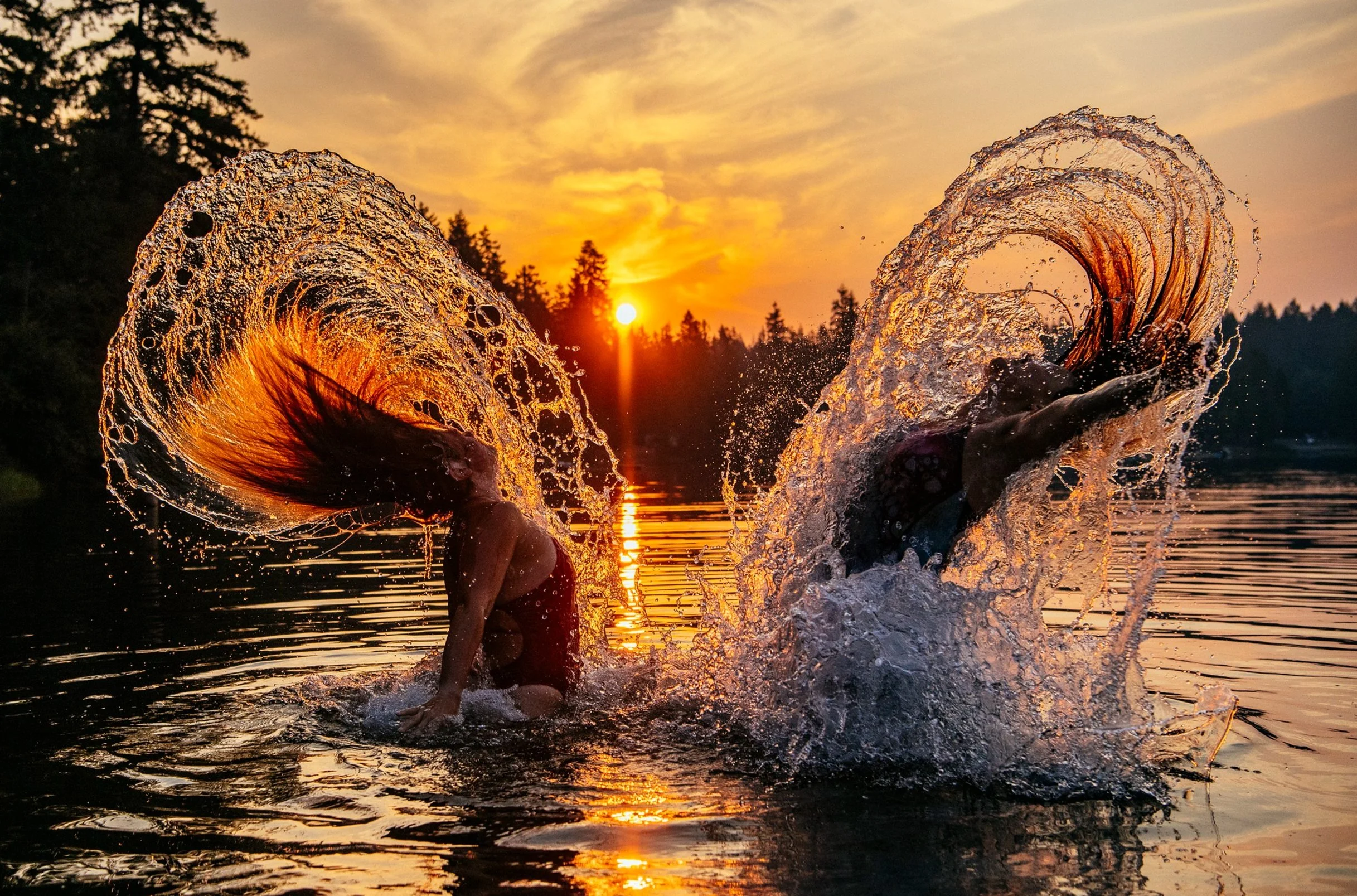wild swimming
Finding strength, beauty & community in the open water
Words by Alorie Gilbert • Photos by Pete Saloutos
An orange sun rises over Wildcat Lake on a warm, hazy morning last August. One by one, six swimsuit-clad friends arrive at the quiet shore, slip on swim caps and goggles and ease into the clear, bath-like water.
They meet here at Wildcat Lake Park, between Seabeck and Bremerton, as often as three mornings a week to swim the length of the lake and back, about a mile and a half. Afterward they share snacks and friendly banter around a picnic table before heading their separate ways. The co-ed group—four women and two men—is undaunted by the poor air quality caused by the summer’s unrelenting wildfires.
“It’s the holy water,” says Pete Saloutos, the group’s organizer, in his customary effusive manner. “It’s what keeps us sane, particularly during COVID. I know that for me, without this lake, I would be hard pressed not to go bonkers.”
Open water swimming groups have proliferated across Puget Sound as interest in the sport took off in 2020. When the coronavirus forced pools and gyms to close and later limit capacity, a flood of new swimmers took to our region’s stunning bays, inlets and lakes as an antidote to anxious times. Spending time in the open water alleviated the isolation and stress that spiked for many over the past two years.
The Western Washington Open Water Swimmers Facebook group, as one indication, has added over a thousand new members since mid-2020 and is now at more than 4,000. It’s an active hub of tips, stories and encouragement among swimmers from Bellingham to Tacoma. Another telling sign: Seattle wetsuit maker blueseventy, a favorite among triathletes, has had a hard time keeping its suits in stock. While that’s partly due to COVID-related supply chain issues, it’s also because of growing demand from people taking up open water swimming, says CEO John Duquette.
“2020 was the first time we sold more women’s suits than men’s, and we sold a lot more entry level products,” Duquette notes. “So the customer itself has changed. We’re dealing with a lot more absolute beginners.”
The Blue Ladies of Langley
Among them is retiree Peggy Taylor of Whidbey Island. Taylor began swimming at a beach near her home in Langley to cope with anxiety brought on by the first waves of the pandemic. Her therapist prompted the idea by asking her about a place she felt most relaxed and at peace. She recalled a blissful moment floating in Desolation Sound off Cortes Island in British Columbia.
“So I went to one of our local beaches called Sandy Point and I tried swimming out. And, lo and behold, it had a hugely positive impact on me,” Taylor recalls. “I would go swimming, and I would feel much better for the rest of the day.”
Even before the pandemic accelerated the trend, researchers were studying cold water immersion as a treatment for depression, anxiety and other ailments. What’s more, cultures around the world, from Japan to Scandinavia, have sworn by cold water plunges for ages.
Taylor could actually feel the anxiety release its grip on her body while in the water. “I became quite dependent on this. I was really struggling,” she reports. “This just made a huge difference for me.”
Taylor and her friend Sally swam nearly every day off the beach at Sandy Point that first summer. They met another Sandy Point swimmer who joined them, followed by more friends and neighbors—all casual swimmers. By January, they were a group of eight women outfitted in wetsuits and protective gear and committed to swimming through the winter— always staying close to shore.
“None of us were like champion swimmers or anything like that,” she noted. “So we made a pact; we wouldn’t go alone.”
They named themselves the Blue Lady Swim Team after a nearby street: Blue Lady Lane. They’ve worked up from spending about 20 minutes in the water to double that, often shedding their wetsuits at the end of a swim—or altogether in the summer months—for an extra dose of cold water therapy that Taylor describes as euphoric. What’s also been uplifting, and a surprise to Taylor, is the deep camaraderie the women have developed swimming together.
“Swim by swim, the friendships would get deeper,” she says. “It’s been very comforting to make some new friends during COVID.”
“A huge boon”
Retired attorney Ken Goodman can attest to the social benefits of open water swimming. In addition to organizing a 30-mile swim relay around Bainbridge Island every August, Goodman is the point person for weekly group swims in Manzanita Bay and Blakely Harbor, starting every spring with a group of 15 or so regulars.
A few years ago, someone in the group brought a six-pack of beer to celebrate one member’s swim around Alcatraz. They all lingered to hear the details of her feat, and a tradition was born. Post-workout imbibing and socializing became a regular thing.
“Eventually our swims started getting shorter and shorter and the after-party got longer and longer,” Goodman muses. “We had people showing up with meals and really good food. So, it was like, ‘How far do you guys want to swim today?’ ‘Oh, I don’t know, half a mile sounds good to me. What do you got to eat?’ It really developed into a social scene.”
Throughout the pandemic, which put a damper on sharing food and drink for a time, gathering for a group swim has been a stress-buster. “It was a huge boon to us because we were still having this social engagement outside of our families,” Goodman says.
As word of the group’s meetups spread, Goodman’s email invite list ballooned to nearly 100 names. A dozen or so newcomers asked to be added last year, while several groups have spun off Goodman’s.
One offshoot braves the Sound without wetsuits (aka skin swimming)—even for an annual 3/4-mile swim on December 31. “They’re all women,” Goodman notes. “We affectionately call them the Nearly Naked Ladies.”
Goal-oriented
Kelly Adamson Danielson is a devotee of open water and also partial to skin swimming. To relieve anxiety and boredom during the spring of 2020, the public school educator completed a 45-mile skin swim around Bainbridge Island (including coves and harbors) in stages, followed by a 10-part swim-run around the island that fall.
But open water swimming is not without risks, and last spring Adamson Danielson encountered one that every saltwater swimmer fears—jellyfish. She collided with a lion’s mane off Blake Island. Lion’s mane is the largest of the jelly species and can stretch as long as 120 feet from top to tentacle tips, which deliver a powerful sting.
“I put my hand right into the inside, so the tentacles just wrapped around my arm. And I skin swim, so I didn’t have any protection on my arm,” she recounts.
Her injury was made worse by a delay in treatment while waiting on the island for help to arrive. Days of extreme discomfort followed. “All of a sudden, my whole arm would just swell up and itch with such intensity,” she added. “I didn’t sleep for three or four days.”
That harrowing experience put her off swimming in the sound for most of last summer. So she took her suit and cap on the road instead and swam in 11 lakes (including four of the five great lakes) with her twin teenage daughters on an eight-day Midwest road trip. On another trip, she swam seven lakes in seven states on a drive home to Bainbridge from Minneapolis.
“I’m a very goal-oriented person,” she says. “Even though they’re often random goals, I have to have something, even if it’s somewhat obscure.”
Take me to church
Adamson Danielson is among those to join Saloutos at Wildcat Lake that August morning. The two met on Bainbridge, frequenting the same sunrise vista point during COVID lockdown. A professional photographer, Saloutos began taking pictures of her on swim excursions. She has become a muse of sorts. At the lake, he shoots her and fellow swimmer Shelley Reimer doing “hairflips”—popping up out of the lake and throwing their heads back, to dramatic effect.
At 74, Saloutos calls himself “the old guy” of the group and prefers lakes over the sea. “For me it serves two purposes,” he says of Wildcat Lake. “One, it’s my place of worship, and it’s my outdoor water studio. It’s majestic, quite a wonderful place. Because it’s fed by aquifers, it supposedly has the best water of all the lakes in Kitsap County.”
Saloutos often refers to Wildcat as “church.” Beyond fitness and stamina, swimming here among the lily pads, darting kingfishers and solitary anglers offers a balm to the soul. Perhaps it’s the meditative quality of swimming, the stunning natural beauty, or being part of a devoted community. Likely it’s all of the above that account for the vitality and joy I noticed in all the swimmers I met for this story.
Contact with the natural world (with the exception of jellies) is cathartic, echoes Taylor of Whidbey Island. The Blue Lady swimmers have observed eagles, dolphins, orcas and gray whales on their outings, and one seal in particular has become a regular companion to the group. Taylor and her friends have also become more finely attuned to seasonal and natural cycles, including tides and water temperatures.
Says Taylor: “Some days, it feels like we've gone into this primordial world, a magical world that no one would ever have a sense of unless you actually did it.”





